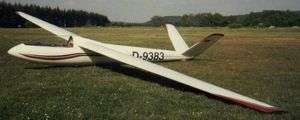Akaflieg Braunschweig SB-5 Danzig
The Akaflieg Braunschweig SB-5 is a German single-seat Standard Class sailplane designed and prototyped by students of Brunswick University.[1] More than 100 were built to their design, in several different variants.[2]
| SB-5 | |
|---|---|
 | |
| SB-5b | |
| Role | Single seat Standard Class glider |
| National origin | West Germany |
| Manufacturer | Fa Eichelsdörfer, Bamberg |
| First flight | 3 June 1959 |
| Number built | 100+ |
Design
The Akaflieg Braunschweig or Akademische Fliegergruppe Braunschweig (English: The Brunswick Academic Flying Group) is one of some fourteen German undergraduate student flying groups attached to and supported by their home Technical University. Several have designed and built aircraft, often technically advanced and leading the development of gliders in particular.[3]
The SB-5 is a cantilever shoulder-wing monoplane with a plywood monocoque fuselage which has an outer fibre glass skin, a single spar wooden wing with plywood skinning, and a V-tail. Its wing, with a constant chord centre section and tapered outer panels,[4] has 2.50° of dihedral and Schempp-Hirth airbrakes at 50% chord. The pilot has an enclosed cockpit with a Plexiglass canopy and the landing gear is a non-retractable, unsprung monowheel with a tailskid.[1][2][5]
The SB-5 prototype first flew on 3 June 1959. A licence to build it went to Firma Eichelsdörfer at Bamberg, who produced more than 100 including all variants.[2] The first three variants, SB-5a-c detailed below, differed chiefly in their forward fuselages and canopy shapes and the last (SB-5e) by having an extended span[4]
Operational history
In 2010, there were thirty seven SB-5s on the German civil register and one each on the Belgian and UK registers. Of these, eighteen were SB-5bs, twenty SB-5es and one a SB-5c.[6][7]
Variants
- SB-5a
- Original version, with a short, tear drop style canopy proud of upper fuselage line. Braking parachute, no air brakes. Only one, crashed June 1961.[4]
- SB-5b
- First production model. Lengthened forward fuselage with pilot in reclined seat under long canopy reaching forward almost to the nose and blended into fuselage line over wings. Airbrakes. Around 50 built.[4]
- SB-5c
- Second production model. Shorter canopy not reaching nose, ground clearance raised by placing monowheel in short fairing rather than directly within fuselage. Some GRP in fuselage. About 10 built.[4] First flown 1965.[2]
- SB-5d
- SB-5e
- 16 m (52 ft 6 in) span to meet Club Class rules. Entered production 1974,[2] with at least 20 built.
Specifications (SB-5c)
Data from Jane's All the World's Aircraft 1966/7[5]
General characteristics
- Crew: One
- Length: 6.6 m (21 ft 8 in)
- Wingspan: 15.00 m (49 ft 3 in)
- Wing area: 13.00 m2 (139.9 sq ft)
- Aspect ratio: 17.3
- Airfoil: NACA 633618
- Empty weight: 220 kg (485 lb) equipped
- Max takeoff weight: 325 kg (717 lb)
Performance
- Maximum speed: 200 km/h (120 mph, 110 kn) smooth air
- Stall speed: 60 km/h (37 mph, 32 kn)
- Maximum glide ratio: best 32.5:1 at 77 km/h; 42 kn (48 mph)
- Rate of sink: 0.63 m/s (124 ft/min) minimum at 66 km/h; 37 kn (41 mph)
- Wing loading: 23.1 kg/m2 (4.7 lb/sq ft) maximum
References
Notes
- Taylor 1973, p. 545
- Hardy 1982 pp.4-5
- Simons 2005 p.41
- Akademische Fliegergruppe Braunschweig e.V. "Akademische Fliegergruppe Braunschweig e.V". Akaflieg-braunschweig.de. Retrieved 2012-07-19.
- Taylor 1966 pp.389-90
- Partington 2010
- GINFO Search Results, Access date 2012-07-19
- Ogden 2009 p.198
Bibliography
- Hardy, Michael (1982). Gliders & Sailplanes of the World. London: Ian Allan Ltd. ISBN 0 7110 1152 4.
- Ogden, Bob (2009). Aviation Museums and Collections of Mainland Europe. Air Britain (Historians) Ltd. ISBN 978 0 85130 418 2.
- Partington, Dave (2010). European registers handbook 2010. Air Britain (Historians) Ltd. ISBN 978-0-85130-425-0.
- Simons, Martin (2005). Sailplanes 1965-2000 (2nd revised ed.). Königswinter: EQIP Werbung & Verlag GmbH. ISBN 3-9808838-1-7.
- Taylor, John W R (1966). Jane's All the World's Aircraft 1966-67. London: Sampson Low, Marston & Co. Ltd.
- Taylor, John W.R., ed. (1973). Jane's All the World's Aircraft 1973-74. London, United Kingdom: Jane's Yearbooks. ISBN 0-354-00117-5.